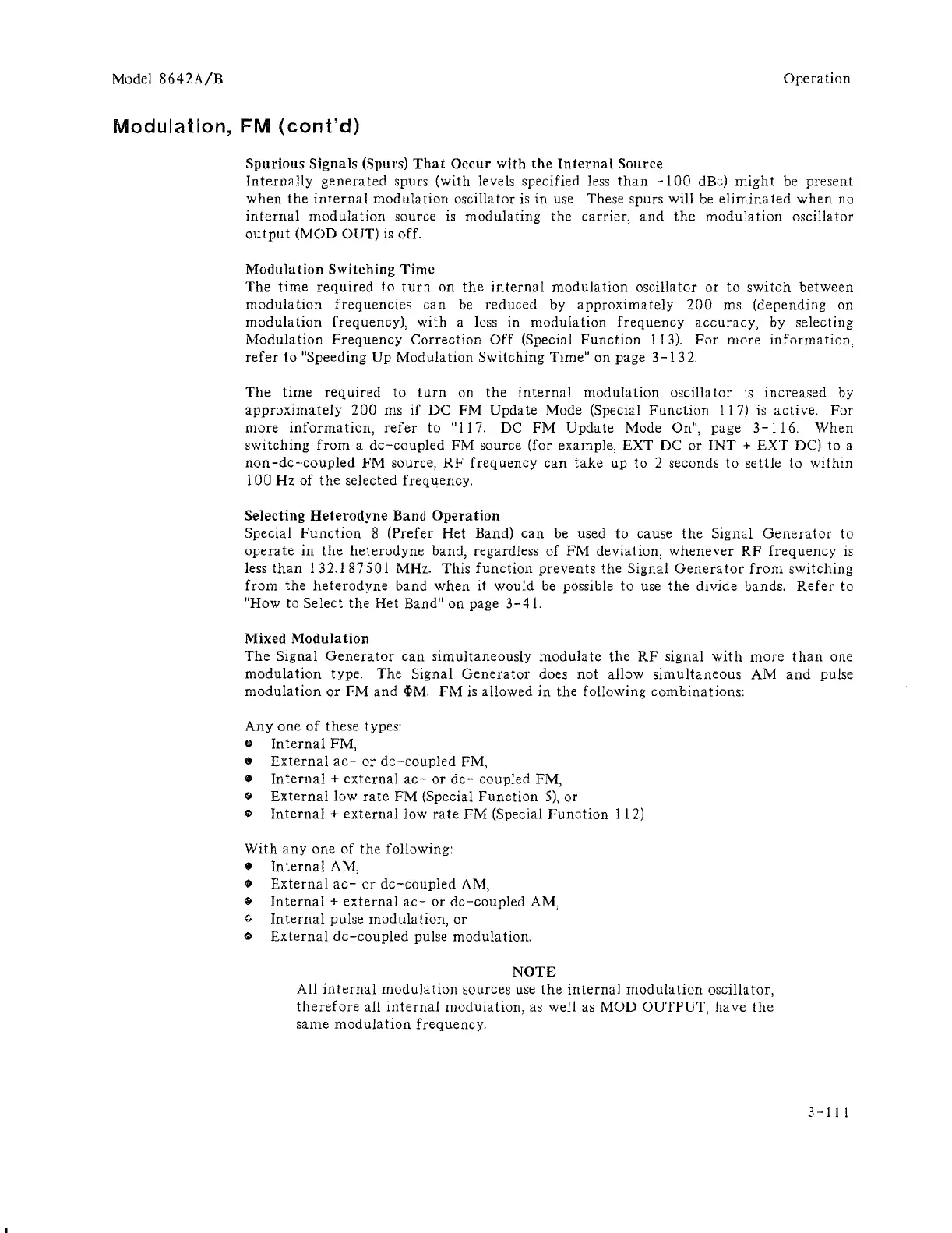Model
8642A/B
Operation
Modulation,
FM
(cont'd)
Spurious
Signals
(Spurs)
That
Occur
with
the
Internal
Source
Internally
generated
spurs (with levels specified less
than
-100
dBc)
might
be present
when
the
internal
modulation
oscillator is
in
use. These spurs will
be
eliminated
when
no
internal
modulation
source
is
modulating
the
carrier,
and
the
modulation
oscillator
output
(MOD OUT)
is
off.
Modulation
Switching
Time
The
time
required
to
turn
on
the
internal
modulation
oscillator or
to
switch
between
modulation
frequencies
can
be
reduced by
approximately
200
ms (depending on
modulation
frequency),
with
a loss in
modulation
frequency
accuracy, by selecting
Modulation
Frequency
Correction
Off
(Special
Function
113).
For
more
information,
refer
to
"Speeding Up Modulation Switching Time" on page
3-132.
The
time
required
to
turn
on
the
internal
modulation
oscillator
is
increased by
approximately
200
ms
if
DC
FM Update Mode (Special
Function
117)
is
active. For
more
information,
refer
to
"117. DC FM Update Mode On", page
3-116.
When
switching
from
a
dc-coupled
FM source (for example, EXT DC or
INT
+
EXT
DC)
to
a
non
-dc-·coupled FM source,
RF
frequency
can
take
up
to
2 seconds
to
settle
to
within
100
Hz
of
the
selected frequency.
Selecting
Heterodyne
Band
Operation
Special
Function
8 (Prefer Het Band)
can
be used to cause
the
Signal
Generator
to
operate
in
the
heterodyne
band, regardless of
FM
deviation,
whenever
RF
frequency
is
less
than
132.187501
MHz. This
function
prevents
the Signal
Generator
from
switching
from
the
heterodyne
band
when
it would be possible
to
use
the
divide bands.
Refer
to
"How to Select the Het Band" on page
3-41.
Mixed
Modulation
The
SIgnal
Generator
can
simultaneously
modulate
the
RF
signal
with
more
than
one
modulation
type. The Signal
Generator
does
not
allow
simultaneous
AM
and
pulse
modulation
or
FM and
<liM.
FM
is
allowed
in
the following combinations:
Anyone
of
these types:
•
Internal
FM,
•
External
ac-
or
dc-coupled
FM,
o
Internal
+
external
ac-
or
dc-
coupled FM,
(1
External
low
rate
FM (Special
Function
5),
or
$
Internal
+
external
low
rate
FM
(Special
Function
112)
With
anyone
of
the following:
•
Internal
AM,
o
External
ac-
or
dc-coupled
AM,
~
Internal
+
external
ac-
or
dc-coupled
AM,
{;
Internal
pulse modula tion, or
o
External
dc-coupled
pulse modulation.
NOTE
All
internal
modulation
sources use
the
internal
modulation
oscillator,
therefore
all
internal
modulation, as well as MOD OUTPUT, have
the
same
modulation
frequency.
3-11
I

